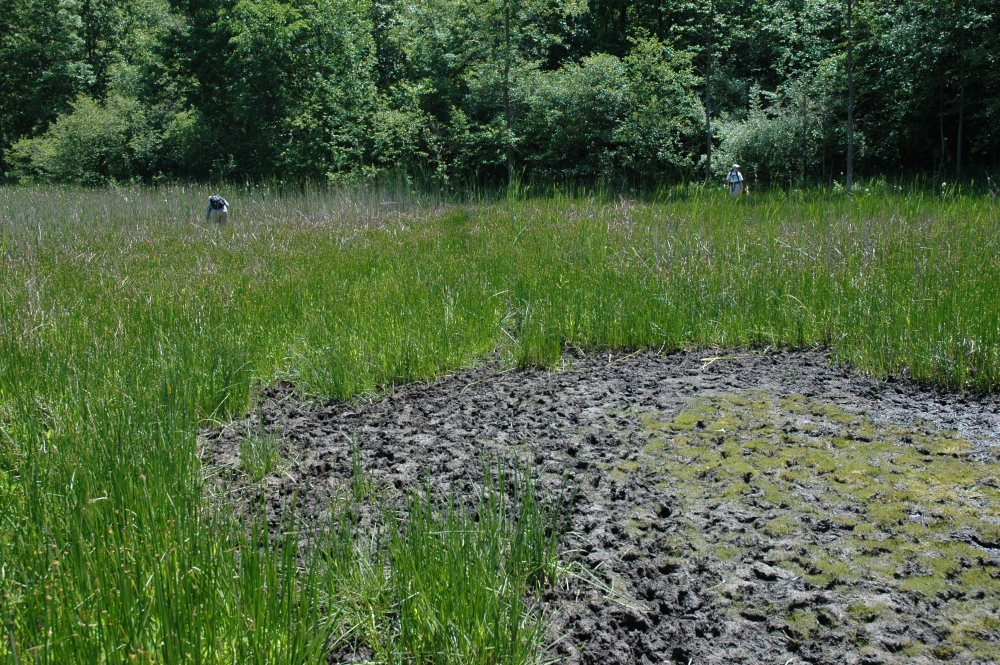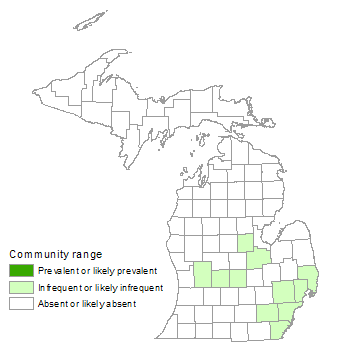Inland Salt Marsh
Overview
Inland salt marsh is an herbaceous wetland occurring on mineral soil saturated by sodium- and chloride-laden groundwater from natural brine aquifers. In Michigan, salt marshes and seeps were concentrated in areas where Silurian or Devonian halites (rock salt deposits) occur near the surface. The only known, intact salt marshes in Michigan today occur along the Maple River in northern Clinton County. Historically, salt marshes were known from elsewhere in Michigan as well as Illinois, Missouri, New York, Ohio, Pennsylvania, and Virginia, but today the community persists only in Illinois, Michigan, and New York.
Rank
Global Rank: G1 - Critically imperiled
State Rank: S1 - Critically imperiled

Landscape Context
Inland salt marshes are most common along streams or rivers, where glacial drift is thin enough to permit brine from deep saline aquifers to remain concentrated and emerge at discrete points.
Soils
This community occurs on peat, muck, or mineral soils saturated by sodium- or chlorine-rich groundwater seeping from saline aquifers. Soils of an intact salt marsh in Michigan were found to be high in sodium, chloride, potassium, calcium, and magnesium and have a pH that ranged from medium acid to moderately alkaline.
Natural Processes
Inland salt marshes often have open, unvegetated seeps and soil patches, where conditions are too extreme for plants to grow. Animals seeking salt create localized disturbances resulting in trampled, unvegetated zones within the wetland. Seasonal and annual fluctuations in the amount of seepage in salt marshes influence species composition, distribution, and establishment. Historically, fire may have also played a role in maintaining the open conditions required by most plant species found in salt marshes.
Vegetation
The extreme saline conditions of inland salt marshes regulate the vegetative composition and structure of the community. A limited number of vascular plant species can tolerate the high salt levels and wetland soils. Characteristic plants on inland salt marsh include water plantain (Alisma subcordatum), dwarf spike-rush (Eleocharis parvula, state endangered), bald spike-rush (E. erythropoda), reed (Phragmites australis subsp. americanus), purslane (Portulaca oleracea), water-pimpernel (Samolus parviflorus), Olney's bulrush (Schoenoplectus americanus, state endangered), and water-parsnip (Sium suave).
For information about plant species, visit the Michigan Flora website.
Plant Lists
Graminoids
- bald spike-rush (Eleocharis erythropoda)
- dwarf spike-rush (Eleocharis parvula)
- reed (Phragmites australis subsp. americanus)
- Olney’s bulrush (Schoenoplectus americanus)
- threesquare (Schoenoplectus pungens)
Forbs
- water plantain (Alisma subcordatum)
- spearscale (Atriplex patula)
- purslane (Portulaca oleracea)
- water-pimpernel (Samolus parviflorus)
- water parsnip (Sium suave)
- broad-leaved cat-tail (Typha latifolia)
Noteworthy Animals
Deer tracks are abundant around inland salt marsh occurrences, and the species may be helping to maintain open conditions. Waterfowl may play a role in the introduction and dispersal of halophytes and other wetland plants.
Rare Plants
- Eleocharis parvula (dwarf spike-rush, state threatened)
- Schoenoplectus americanus (Olney’s bulrush, state threatened)
Rare Animals
- Emydoidea blandingii (Blanding’s turtle, state special concern)
Biodiversity Management Considerations
As salt was an important food preservative during European settlement of the Midwest, most salt marshes and seeps were heavily exploited. Conservation efforts should focus on protecting, managing, and researching existing inland salt marshes. Protection of inland salt marshes will require preserving the hydrologic integrity of the surrounding watershed. Further research on the role of fire in inland salt marshes is needed, as are detailed invertebrate and herptile surveys.
Variation
Species composition and community size likely varied regionally.
Similar Natural Communities
Places to Visit
- Maple River, Maple River State Game Area, Clinton Co.
Relevant Literature
- Albert, D.A. 2001. Natural community abstract for inland salt marsh. Michigan Natural Features Inventory, Lansing, MI. 3 pp.
- Allen, R.C. 1918. Mineral resources of Michigan for 1917 and prior years. Mich. Geol. and Biol. Survey Publ. 27, Geo. Series 22. 204 pp.
- Chapman, K.A., V.L. Dunevitz, and H.T. Kuhn. 1985. Vegetation and chemical analysis of a salt marsh in Clinton County, Michigan. Michigan Botanist 24: 135-144.
- Cook, W.C. 1914. The brine and salt deposits of Michigan. Mich. Geol. and Biol. Survey Publ. 15, Geo. Series 12. 188 pp.
- Gere, M.A. 1979. Michigan mineral producers, 1978. Geology Division, Michigan DNR, Lansing, MI. pp. 25-27, 32-33.
For a full list of references used to create this description, please refer to the natural community abstract for Inland Salt Marsh.
More Information
Citation
Cohen, J.G., M.A. Kost, B.S. Slaughter, D.A. Albert, J.M. Lincoln, A.P. Kortenhoven, C.M. Wilton, H.D. Enander, and K.M. Korroch. 2020. Michigan Natural Community Classification [web application]. Michigan Natural Features Inventory, Michigan State University Extension, Lansing, Michigan. Available https://mnfi.anr.msu.edu/communities/classification. (Accessed: December 26, 2025).
Kost, M.A., D.A. Albert, J.G. Cohen, B.S. Slaughter, R.K. Schillo, C.R. Weber, and K.A. Chapman. 2007. Natural Communities of Michigan: Classification and Description. Michigan Natural Features Inventory, Report No. 2007-21, Lansing, MI.


